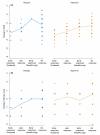Vitamin E and changes in serum alanine aminotransferase levels in patients with non-alcoholic steatohepatitis
- PMID: 23718573
- PMCID: PMC3775262
- DOI: 10.1111/apt.12352
Vitamin E and changes in serum alanine aminotransferase levels in patients with non-alcoholic steatohepatitis
Abstract
Background: Non-alcoholic steatohepatitis (NASH) is a common cause of serum alanine aminotransferase (ALT) elevations and chronic liver disease, but it is unclear how well ALT elevations reflect the liver injury.
Aim: To assess how well changes in ALT elevations reflect improvements in liver histology in response to vitamin E therapy.
Methods: The vitamin E and placebo arms of the Pioglitazone vs. Vitamin E vs. Placebo in Non-alcoholic Steatohepatitis (PIVENS) trial were reassessed for associations among changes in ALT levels, body weight and liver histology. An ALT response was defined as a decrease to ≤40 U/L and by ≥30% of baseline. Liver biopsies taken before and after treatment were scored for non-alcoholic fatty liver disease activity (NAS) and fibrosis.
Results: ALT responses were more frequent among vitamin E (48%) than placebo (16%) recipients (P < 0.001). Among vitamin E recipients, ALT responses were associated with decreases in NAS (P < 0.001), but not fibrosis scores (P = 0.34), whereas among placebo recipients, ALT responses were associated with significant decreases in both (P < 0.05). Weight loss (≥2 kg) was also associated with ALT response (P < 0.001), improvements in NAS (P < 0.001) and fibrosis (P < 0.02), but vitamin E had an added effect both with and without weight loss. Weight gain (≥2 kg) was associated with lack of ALT response and worsening NAS and fibrosis scores in patients not on vitamin E.
Conclusions: Decrease of ALT levels to normal in patients with NASH is usually associated with improved histological activity. Management should stress the value of weight loss and strongly discourage weight gain. Vitamin E can improve both ALT levels and histology with and without weight loss.
Clinical trial number: NCT00063622.
Published 2013. This article is a US Government work and is in the public domain in the USA.
Figures



References
-
- Kowdley KV, Mason JB, Meydani SN, Cornwall S, Grand RJ. Vitamin E deficiency and impaired cellular immunity related to intestinal fat malabsorption. Gastroenterology. 1992;102:2139–42. - PubMed
-
- Tanyel MC, Mancano LD. Neurologic findings in vitamin E deficiency. Am Fam Physician. 1997;55:197–201. - PubMed
-
- Sokol RJ, Balistreri WF, Hoofnagle JH, Jones EA. Vitamin E deficiency in adults with chronic liver disease. Am J Clin Nutr. 1985;41:66–72. - PubMed
-
- Lee IM, Cook NR, Gaziano JM, et al. Vitamin E in the primary prevention of cardiovascular disease and cancer: the Women’s Health Study: a randomized controlled trial. JAMA. 2005;294:56–65. - PubMed
Publication types
MeSH terms
Substances
Associated data
Grants and funding
- U01DK061731/DK/NIDDK NIH HHS/United States
- U01 DK061731/DK/NIDDK NIH HHS/United States
- U01 DK061718/DK/NIDDK NIH HHS/United States
- UL1 TR000058/TR/NCATS NIH HHS/United States
- U01 DK061730/DK/NIDDK NIH HHS/United States
- U01DK061738/DK/NIDDK NIH HHS/United States
- U01DK061730/DK/NIDDK NIH HHS/United States
- U01 DK061737/DK/NIDDK NIH HHS/United States
- U01 DK061713/DK/NIDDK NIH HHS/United States
- UL1 RR024989/RR/NCRR NIH HHS/United States
- U01DK061713/DK/NIDDK NIH HHS/United States
- UL1 RR025761/RR/NCRR NIH HHS/United States
- UL1RR24156/RR/NCRR NIH HHS/United States
- UL1RR029887/RR/NCRR NIH HHS/United States
- U01 DK061732/DK/NIDDK NIH HHS/United States
- UL1RR025741/RR/NCRR NIH HHS/United States
- UL1RR025761/RR/NCRR NIH HHS/United States
- U01DK061737/DK/NIDDK NIH HHS/United States
- P30 DK026743/DK/NIDDK NIH HHS/United States
- P30 DK079637/DK/NIDDK NIH HHS/United States
- UL1 RR024156/RR/NCRR NIH HHS/United States
- M01 RR000188/RR/NCRR NIH HHS/United States
- UL1 RR025741/RR/NCRR NIH HHS/United States
- UL1 RR024131/RR/NCRR NIH HHS/United States
- U01DK061718/DK/NIDDK NIH HHS/United States
- UL1RR031990/RR/NCRR NIH HHS/United States
- UL1RR025055/RR/NCRR NIH HHS/United States
- U01DK061732/DK/NIDDK NIH HHS/United States
- U01DK061728/DK/NIDDK NIH HHS/United States
- UL1 RR031990/RR/NCRR NIH HHS/United States
- U01 DK061728/DK/NIDDK NIH HHS/United States
- UL1RR025014/RR/NCRR NIH HHS/United States
- UL1 RR025014/RR/NCRR NIH HHS/United States
- K23 DK090303/DK/NIDDK NIH HHS/United States
- U01 DK061738/DK/NIDDK NIH HHS/United States
- UL1RR024989/RR/NCRR NIH HHS/United States
- UL1RR024131/RR/NCRR NIH HHS/United States
- ImNIH/Intramural NIH HHS/United States
- U01 DK061734/DK/NIDDK NIH HHS/United States
- UL1 RR031980/RR/NCRR NIH HHS/United States
- UL1RR031980/RR/NCRR NIH HHS/United States
- UL1 RR029887/RR/NCRR NIH HHS/United States
- M01RR00188/RR/NCRR NIH HHS/United States
- U01DK061734/DK/NIDDK NIH HHS/United States
- S10 RR025055/RR/NCRR NIH HHS/United States
LinkOut - more resources
Full Text Sources
Other Literature Sources
Medical
